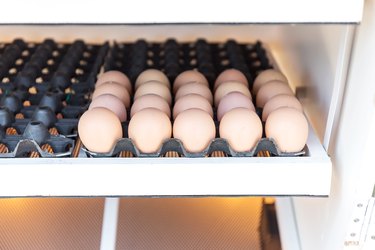
In the laboratory setting, it's often necessary to heat items or keep small animals or organisms warm. These tasks can be performed with an incubator or an oven. To understand the differences between an incubator and an oven, it helps to learn the uses for each item. Both devices heat, but that is the end of their similarities.
Incubator Basics
Video of the Day
An incubator is an enclosed device that provides a controlled environment for various tasks. These tasks include keeping young animals at the required temperature for birth or growth. For instance, growing baby chicks or warming fertile eggs for hatching.
Video of the Day
An incubator also offers a controlled environment for the growth of microorganisms. This is useful for scientific tasks like growing microbial cultures. Included in this category is the use of BOD incubator in microbiology. BOD (biological oxygen demand) incubators work at low temperatures to incubate substances such as yeast and mold. This task is generally completed between 68 degrees F and 77 degrees F.
Incubator vs. Oven
When reviewing the differences between an oven and incubator, it helps to look at temperature ranges. Incubators usually heat in the range of 77 degrees F to 104 degrees F. The temperature used will depend on the task. For instance, according to Backyard Chicken Coops, eggs should be hatched between 98.6 degrees F and 102.2 degrees F. If you incubate eggs at lower than recommended temperatures, the embryos may die. Eggs incubated at higher temperatures than suggested will hatch too soon and may be deformed.
Laboratory Oven Basics
In addition to baking food in the kitchen setting, an oven is widely used in laboratories. Many fields use laboratory ovens. These include biology, chemistry, physics, electronics, forensics and pharmaceuticals. Ovens generally range in temperature capability from 150 degrees F to over 1,472 degrees F. The high temperatures that ovens reach is another one of the differences between an incubator and an oven.
Various types of laboratory ovens exist. These include hot air ovens, used to sterilize laboratory instruments such as glassware and scalpels. Annealing ovens are used for heating and cooling items to strengthen them. Drying ovens are used to ensure that all moisture is removed from items. Die-bond curing ovens harden the chemical composition of items.
How Eggs Hatch in Incubators
While the ideal location for hatching eggs is under the mother hen, eggs are routinely hatched in incubators. It takes 21 days for eggs to incubate prior to hatching. For the best results, choose an incubator with some automatic features. These include auto-egg-turning. Regular turning prevents baby chicks from sticking to the insides of their shells.
If you don't have an auto-egg-turning feature in your incubator, it's necessary to manually turn the eggs at least three times a day. Each time you turn them, change the area on which the egg is resting. To ensure you don't place the egg on the same side in one day, turn it an odd number of times. When turning, don't place the eggs on the small end tip.
Regulate Incubator Air Circulation
Incubator models with fans are suggested, especially for incubating chicks or their eggs. Air circulation ensures that heat is evenly distributed within the incubator. For hatching fertile eggs, relative humidity within the incubator until day 17 should be 50 to 55 percent. From days 18 to 21, it's important that the humidity level rises to 70 percent.
Humidity can be raised in the incubator by placing a wet sponge or pan filled with water inside. This will release humidity into the incubator. Keep tabs on the humidity level inside the incubator with a hygrometer, which measures relative humidity.
Shortly before hatching, eggs may shift on their own. This indicates the chick fetus is active. Before hatching, the chick will peck a small hole in the large end of the egg in order to breathe. Once this is done, the chick will likely rest for six to 12 hours during which time its lungs form. Once the lungs are formed, the chick will peck its way out of the shell.